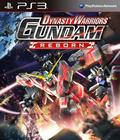Dynasty Warriors: Gundam Reborn is effectively Dynasty Warriors: Gundam 4. It contains new content in addition to almost all of the characters and units from the previous games. In addition to Gundam, Zeta Gundam, and Char's Counterattack, there are also Official Modes for Gundam SEED, Gundam SEED Destiny, and the first five episodes of Gundam Unicorn. A new Ultimate Mode pits the players against crossover storylines involving the various Gundam characters from the game. These stories are mostly silly and lighthearted and involve ridiculous cameos and interactions that could never happen in the canonical tales. They're also simply told, with the story told in visual novel-style cut scenes between missions.
One thing that really has to be said is that the translation is quite poor. Names are inconsistently translated, and dialogue is inaccurate. In some cases, you're given the opposite of what the game tells you. One frequent error involves the game telling you, "Make sure to shoot down the carrier" when it should actually say, "Make sure your carrier doesn't get shot down!" There are a number of big and small errors, and many of them should have been caught by some basic QA.
The core gameplay hasn't changed much in Reborn. You play as a single powerful unit on a map with cannon fodder and a few powerful units. Reborn still uses the "field" system found in previous games, where you can conquer parts of the battlefield by defeating all enemies in a designated area. The only change is the inclusion of mobile fields, which are connected to enemy soldiers or battleships and continue to spawn enemies. The only way to defeat them is to destroy the leader. For battleships, this means defeating mobile suit forces while avoiding cannon barrages.
The biggest addition to the gameplay is Burst mode, which has a lot in common with Rage mode in Dynasty Warriors 8. A bar fills up as you kill enemies with SP attacks. When it's full, you can activate Burst mode, which gives you a special ability based on the unit and the pilot you use. Every pilot has an ability, although many are shared with other similar pilots. In addition, Burst mode allows you to perform a combination burst attack, which performs your character's SP attack and the SP attack of a chosen "partner" character. Partner characters include playable units and non-playable units, like battleships. Using a combination burst attack instantly ends Burst mode, but it can be done at any time.
Dynasty Warriors: Gundam Reborn is probably the least grindy of the Dynasty Warriors Gundam games to date. The new upgrade system looks grindy at first glance. You have "part plans," which are ranked from E to S. Each part has associated stats, and you can combine plans to get improved stats. You earn more plans for shooting down enemies, and you can also spend items to increase your weapon power. Shooting down 10,000 enemies with any given unit awards you with an S-Rank plan, which is good enough to carry you through the rest of the game. Since you're shooting down 1,000+ enemies a stage, hitting this number takes no time at all.
Pilots level up individually, separate from their units. A pilot gains traditional RPG levels by killing enemies and can earn "team points," which can be spent to unlock new skills for the pilot. You only need to level up one pilot. As you progress, you unlock training options that can instantly shoot a pilot to level 30 or higher in a few seconds. You can also set multiple favorite pilots who earn Team Points with every mission. It doesn't take much to get a new pilot up to combat readiness, especially since there isn't much to spend money on aside from training. Upgrading units costs money, but it's a pittance, so you might as well max out the pilots.
In fact the only real grind in the game is unlocking units, which are initially locked to their canonical pilots. Only Amuro can pilot the RX-78-2 Gundam, only Banagher can pilot the Unicorn Gundam, and so on. To unlock the units for every pilot, you have to use the unit for 10 missions or so. It's rather tiring as an unlock method. The easiest way to grind it out is to pick a duel map with a one-on-one fight and finish it a few times. It's not a lengthy process but tedious considering how the rest of the game almost eliminates grinding. It's also a frustratingly lengthy process to unlock certain units.
Dynasty Warriors: Gundam Reborn features new story modes and a number of new units from Gundam Unicorn and Gundam SEED. There's a healthy selection of new units, but they're so thinly spread that it may be disappointing to longtime players hoping for absent units to be added to the mix. Gundam Wing, for example, is still missing Altron Gundam and Sandrock Gundam, and G Gundam is still missing the bulk of its cast. The new units are genuinely enjoyable and have many distinctive moves and abilities. They're a varied mix of "full" units with six attacks and lower-tier units with fewer available attacks. There are also DLC units available, but they are new units for existing pilots, such as the Crossbone or Wing Zero Custom Gundams.
New to the Dynasty Warriors Gundam franchise are Mobile Armor units, which have appeared in previous games as boss characters but are now playable. They have only a few attack strings and a simple SP attack but exchange complexity for sheer power. Any of the Mobile Armor units is capable of obliterating entire battlefields in moments, and their damage output is through the roof. They still exist as boss characters within the main game, and the boss versions have breakable limbs and more durability, but that's about the extent of the difference. The units are actually pretty boring once you get over the fun of spamming lasers. They lack interesting combo moves, and their unwieldy size makes it difficult to see the battlefield in indoor missions.
Dynasty Warriors Gundam Reborn's biggest core problem is that it is far too easy, even by the standards of Dynasty Warriors games. The tools are overpowered for the enemies you'll face. SP attacks restore Burst mode, which is incredibly powerful and restores SP attacks. A number of the units can rotate between SP attacks and Burst mode attacks to form a nearly infinite and unbroken string of super moves that obliterate everything. Even if you choose not to use this tactic, the new Mobile Armor type units are so overpowered that they can trivialize even the hardest missions. The new leveling system is a nice way to avoid a grind, but at the same time, it's far too easy to get high-level plans for your robots, further compounding the issue. The gameplay is fun enough, but the low difficulty leaves it feeling the same after a while. Dynasty Warriors 8 has a nice sense of progression where you move from low-level combat to high-powered moves, but Gundam Reborn lacks that.
This also stands out with the game's awkwardly implemented multiplayer mode. The basic premise is cool. You can send out an S.O.S. that allows any online player to join you after they've finished a mission. The implementation is awkward, though. Actually joining a mission involves fiddling with menus, skipping cut scenes, and hoping someone else hasn't already joined the mission by the time you get in. Once you join, the missions aren't rebalanced for two units. Having some missions designed with the idea of two powerful players would add to the game's length. Instead, I quickly grew bored after a few S.O.S missions, and many players seemed to avoid them.
Gundam Reborn does away with the cel-shaded visuals of the last game in favor of more traditional 3-D models. They models aren't bad, and the attack animations for some of the new units are top-notch. The cel-shading gave the game a flair that is missing now. The battlefields are mostly based on Gundam locations but fail to capture the feel of those battlefields, and they're recycled so often that they lose their impact. There is no English dub, so the only choice is Japanese voice acting. The voice acting is not bad, but those who are used to the English voices may have a hard time adapting. The music has been replaced by generic songs that don't stand out. The game supports a custom soundtrack feature, so you can set any song you want, and that goes a long way toward making up for the generic music.
Dynasty Warriors: Gundam Reborn is rather unexceptional. It improves over the previous games in a number of ways, but not every change is for the better. The low-quality translation and incredible ease of the game hold it back. The fun of collecting new units or loot is lost when there's nothing dangerous to take them away again, and the game falls into repetition faster than usual, even for Dynasty Warriors games. The fan service and familiar characters can carry it for die-hard Gundam faithful, but anyone else would be better off playing any of the far better Dynasty Warriors titles.
Score: 6.0/10
More articles about Dynasty Warriors: Gundam Reborn











 Experience the thrill of piloting mobile suits through famous scenes spanning multiple Gundam anime series in an action-packed thrill ride.
Experience the thrill of piloting mobile suits through famous scenes spanning multiple Gundam anime series in an action-packed thrill ride.








































